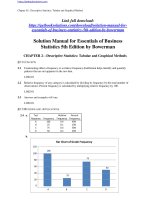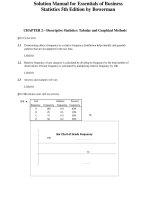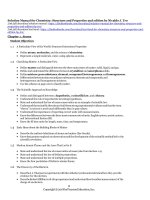Solution manual for financial markets and institutions 7th edition by mishkin
Bạn đang xem bản rút gọn của tài liệu. Xem và tải ngay bản đầy đủ của tài liệu tại đây (405.25 KB, 5 trang )
buy this full document at
Part I
Introduction
buy this full document at http://testbank.us
1Mishkin/EakinsãFinancialMarketsandInstitutions,SeventhEdition
Chapter1
WhyStudyFinancialMarkets
andInstitutions?
WhyStudyFinancialMarkets?
DebtMarketsandInterestRates
TheStockMarket
TheForeignExchangeMarket
WhyStudyFinancialInstitutions?
StructureoftheFinancialSystem
FinancialCrises
CentralBanksandtheConductofMonetaryPolicy
TheInternationalFinancialSystem
BanksandOtherFinancialInstitutions
FinancialInnovation
ManagingRiskinFinancialInstitutions
AppliedManagerialPerspective
HowWeWillStudyFinancialMarketsandInstitutions
ExploringtheWeb
CollectingandGraphingData
WebExercise
ConcludingRemarks
OverviewandTeachingTips
Beforeembarkingonastudyoffinancialmarketsandinstitutions,thestudentmustbeconvincedthatthis
subjectisworthstudying.Chapter1pursuesthisgoalbyshowingthestudentthatfinancialmarketsand
institutionsisanexcitingfieldbecauseitfocusesonphenomenathataffecteverydaylife.Anadditional
purposeofChapter1istoprovideanoverviewfortheentirebook,previewingthetopicsthatwillbe
coveredinlaterchapters.Thechapteralsoprovidesthestudentswithaguideastohowtheywillbestudying
financialmarketsandinstitutionswithaunifying,analyticframeworkandanappliedmanagerialperspective.
â2012PearsonEducation,Inc.PublishingasPrenticeHall
buy this full document at
In teaching this chapter, the most important goal should be to get the student excited about the material. I have
found that talking about the data presented in the figures helps achieve this goal by showing the students that
the subject matter of financial markets and institutions has realworld implications that they should care about.
In addition, it is important to emphasize to the students that the course will have an applied managerial
perspective, which they will find useful latter in their careers. Going through the web exercise is also a way of
encouraging the students to use the web to further their understanding of financial markets and institutions.
Answers to EndofChapter Questions
1. Because they channel funds from those who do not have a productive use for them to those who do,
thereby resulting in higher economic efficiency.
2. Businesses would cut investment spending because the cost of financing this spending is now higher,
and consumers would be less likely to purchase a house or a car because the cost of financing their
purchase is higher.
3. A change in interest rates affects the cost of acquiring funds for financial institution as well as
changes the income on assets such as loans, both of which affect profits. In addition, changes in
interest rates affect the price of assets such as stock and bonds that the financial institution owns
which can lead to profits or losses.
4. No. People who borrow to purchase a house or a car are worse off because it costs them more to finance
their purchase; however, savers benefit because they can earn higher interest rates on their savings.
5. The lower price for a firm’s shares means that it can raise a smaller amount of funds, and so investment
in plant and equipment will fall.
6. Higher stock prices mean that consumers’ wealth is higher and so they will be more likely to increase
their spending.
7. It makes foreign goods more expensive and so British consumers will buy less foreign goods and
more domestic goods.
8. It makes British goods more expensive relative to American goods. American businesses will find it
easier to sell their goods in the United States and abroad, and the demand for their products will rise.
9. Changes in foreign exchange rates change the value of assets held by financial institutions and thus
lead to gains and losses on these assets. Also changes in foreign exchange rates affect the profits
made by traders in foreign exchange who work for financial institutions.
10. In the mid to late 1970s and the late 1980s and early 1990s, the value of the dollar was low, making
travel abroad relatively more expensive; that would have been a good time to vacation in the United
States and see the Grand Canyon. As the dollar’s value rose in the early 1980s, travel abroad became
relatively cheaper, making it a good time to visit the Tower of London.
11. Banks accept deposits and then use the resulting funds to make loans.
12. Savings and loan associations, mutual savings banks, credit unions, insurance companies, mutual
funds, pension funds, and finance companies.
13. Answers will vary.
© 2012 Pearson Education, Inc. Publishing as Prentice Hall
3Mishkin/EakinsãFinancialMarketsandInstitutions,SeventhEdition
14. Theprofitabilityoffinancialinstitutionsisaffectedbychangesininterestrates,stockprices,and
foreignexchangerates;fluctuationsinthesevariablesexposetheseinstitutionstorisk.
15. BecausetheFederalReserveaffectsinterestrates,inflation,andbusinesscycles,allofwhichhave
animportantimpactontheprofitabilityoffinancialinstitutions.
â2012PearsonEducation,Inc.PublishingasPrenticeHall
Full file at />
Quantitative Problems
1.
The following table lists foreign exchange rates between U.S. dollars and British pounds during April:
Date
U.S. Dollars per
GBP
Date
4/1
4/4
4/5
4/6
4/7
4/8
4/11
4/12
4/13
4/14
4/15
1.9564
1.9293
1.914
1.9374
1.961
1.8925
1.8822
1.8558
1.796
1.7902
1.7785
4/18
4/19
4/20
4/21
4/22
4/25
4/26
4/27
4/28
4/29
U.S. Dollars per GBP
1.7504
1.7255
1.6914
1.672
1.6684
1.6674
1.6857
1.6925
1.7201
1.7512
Which day would have been the best day to convert $200 into British pounds?
Which day would have been the worst day? What would be the difference in pounds?
Solution: The best day is 4/25. At a rate of $1.6674/pound, you would have £119.95. The worst
day is 4/7. At $1.961/pound, you would have £101.99, or a difference of £17.96.
© 2012 Pearson Education, Inc. Publishing as Prentice Hall









